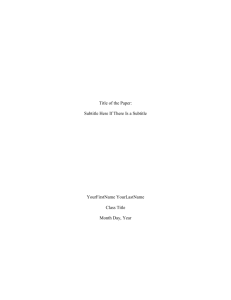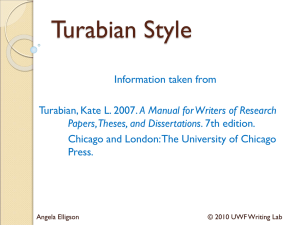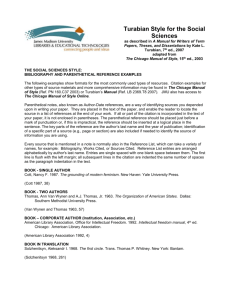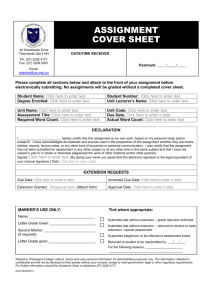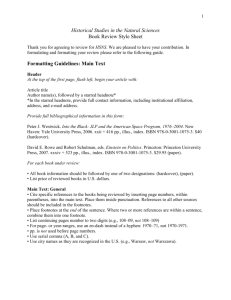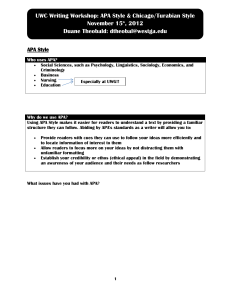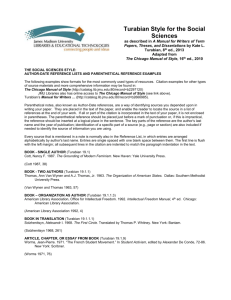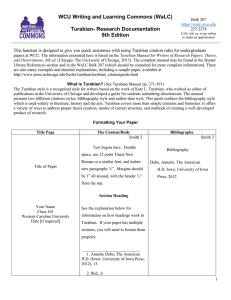Turabian/Chicago Footnotes
advertisement
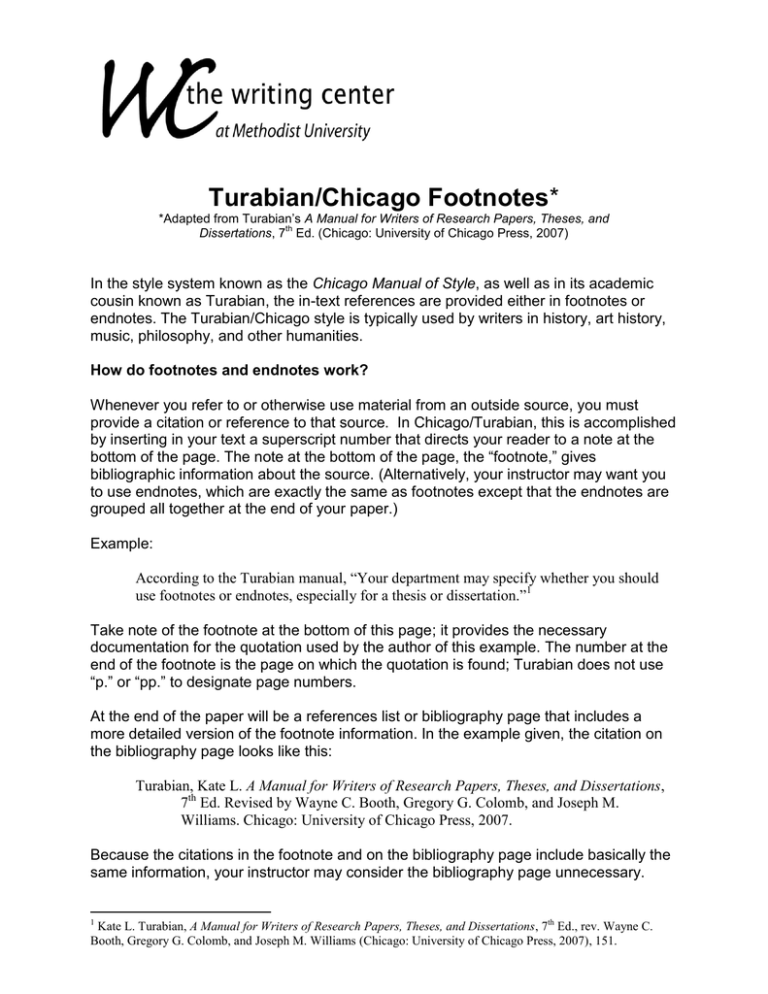
Turabian/Chicago Footnotes* *Adapted from Turabian’s A Manual for Writers of Research Papers, Theses, and th Dissertations, 7 Ed. (Chicago: University of Chicago Press, 2007) In the style system known as the Chicago Manual of Style, as well as in its academic cousin known as Turabian, the in-text references are provided either in footnotes or endnotes. The Turabian/Chicago style is typically used by writers in history, art history, music, philosophy, and other humanities. How do footnotes and endnotes work? Whenever you refer to or otherwise use material from an outside source, you must provide a citation or reference to that source. In Chicago/Turabian, this is accomplished by inserting in your text a superscript number that directs your reader to a note at the bottom of the page. The note at the bottom of the page, the “footnote,” gives bibliographic information about the source. (Alternatively, your instructor may want you to use endnotes, which are exactly the same as footnotes except that the endnotes are grouped all together at the end of your paper.) Example: According to the Turabian manual, “Your department may specify whether you should use footnotes or endnotes, especially for a thesis or dissertation.”1 Take note of the footnote at the bottom of this page; it provides the necessary documentation for the quotation used by the author of this example. The number at the end of the footnote is the page on which the quotation is found; Turabian does not use “p.” or “pp.” to designate page numbers. At the end of the paper will be a references list or bibliography page that includes a more detailed version of the footnote information. In the example given, the citation on the bibliography page looks like this: Turabian, Kate L. A Manual for Writers of Research Papers, Theses, and Dissertations, 7th Ed. Revised by Wayne C. Booth, Gregory G. Colomb, and Joseph M. Williams. Chicago: University of Chicago Press, 2007. Because the citations in the footnote and on the bibliography page include basically the same information, your instructor may consider the bibliography page unnecessary. 1 Kate L. Turabian, A Manual for Writers of Research Papers, Theses, and Dissertations, 7th Ed., rev. Wayne C. Booth, Gregory G. Colomb, and Joseph M. Williams (Chicago: University of Chicago Press, 2007), 151. If citing the same source more than once, can the writer shorten the bibliographic information in the footnote? The short answer is “yes.” The longer answer is that there are two different ways to do this, depending in the circumstances. First, if (1) you have just cited the same source in the immediately preceding footnote and (2) that footnote is on the same page as your new footnote, you can substitute the word “Ibid.” in place of the bibliographic information. Example: 1 Kate L. Turabian, A Manual for Writers of Research Papers, Theses, and Dissertations, 7th Ed., rev. Wayne C. Booth, Gregory G. Colomb, and Joseph M. Williams (Chicago: University of Chicago Press, 2007), 151. 2 Ibid., 4. Ibid. is an abbreviation for the Latin word ibidem, which means “in the same place.” Remember that you can use ”Ibid.” only if your footnote immediately follows a footnote to the same source and only if both citations are on the same page. Second, if you have cited the same source previously in your paper, whether or not on the same page as your new citation, you can shorten the bibliographic information to the author or authors’ last name(s), a short version of the title, and page numbers. Example: 1 Kate L. Turabian, A Manual for Writers of Research Papers, Theses, and Dissertations, 7 Ed., rev. Wayne C. Booth, Gregory G. Colomb, and Joseph M. Williams (Chicago: University of Chicago Press, 2007), 151. th 2 Elizabeth Gilbert, Eat, Pray, Love (New York: Penguin Books, 2006), 10. 3 Turabian, A Manual for Writers, 4. The shortened note provides enough information for your reader to find the full citation in your bibliography or in an earlier note. For additional help with Turabian style documentation, you can always schedule an appointment with a Writing Center consultant (Go to https://methodist.mywconline.com). You can also take a look at the light blue pages in The Little, Brown Essential Handbook, available at the Writing Center and the MU bookstore, or go to the website of Purdue OWL and search for “Turabian documentation” or “Chicago Manual.”
